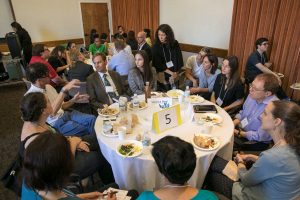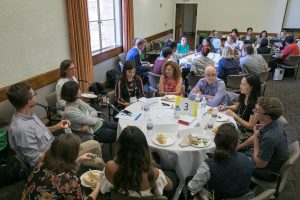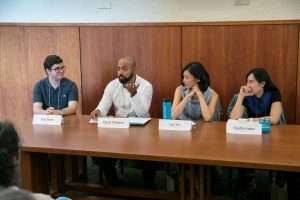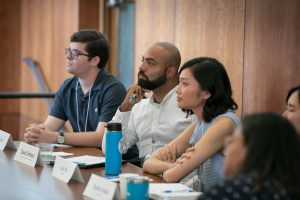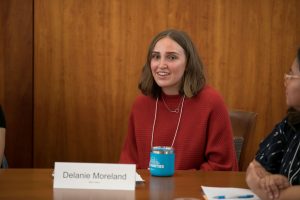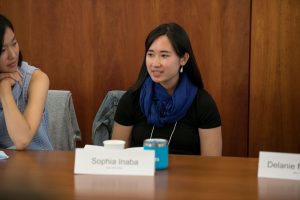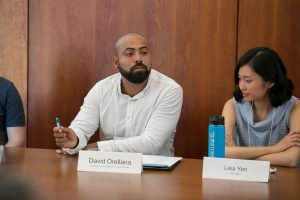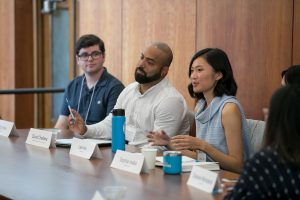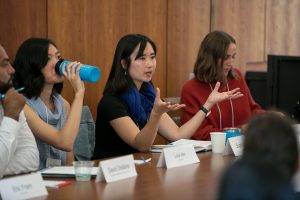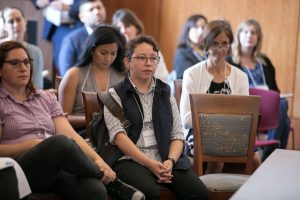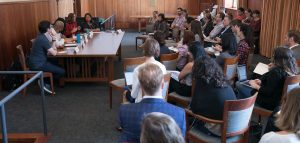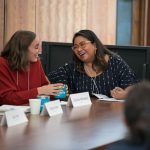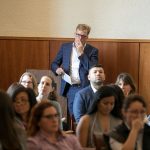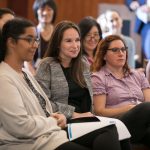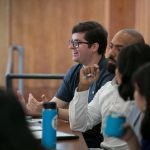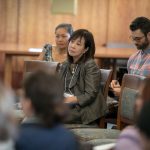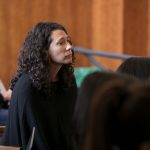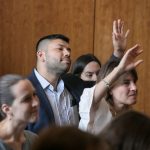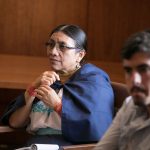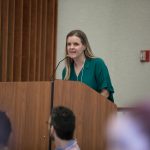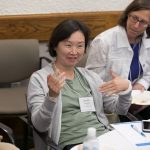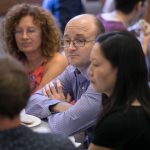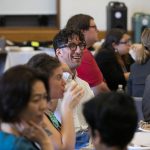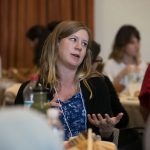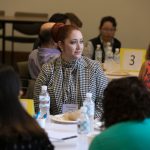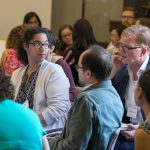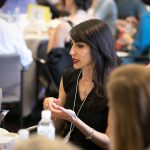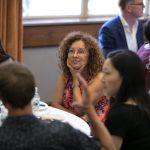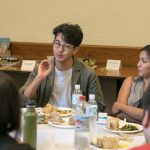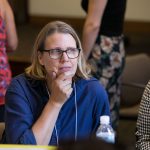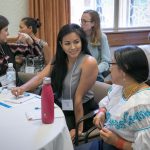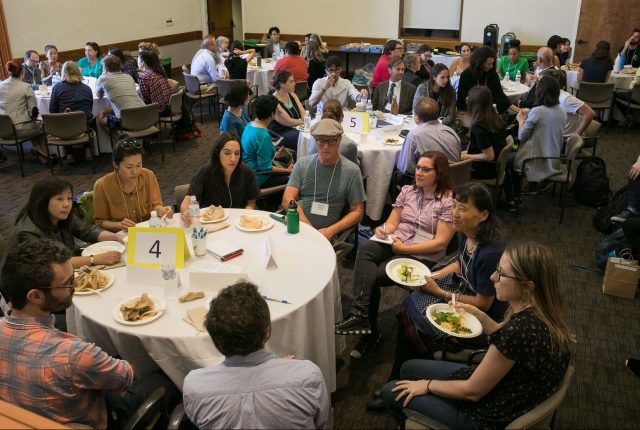
For many instructors at UCLA, Zero Week is a transitional time spent enjoying the last of summer vacation and getting ready to meet and teach a new cohort of students. On September 26, 2018, EPIC aimed to make this transition smoother by welcoming instructors back into the academic year with its inaugural Ready, Set, Teach! symposium. This event brought together nearly ninety instructors from across the Humanities to have a conversation about teaching. As Dean David Schaberg explained in his opening remarks, the aim of Ready, Set, Teach! was to have a “free, open discussion” about what is working in the Humanities classroom and what is not, as well as to learn directly from UCLA undergraduates about their experiences as Humanities majors.
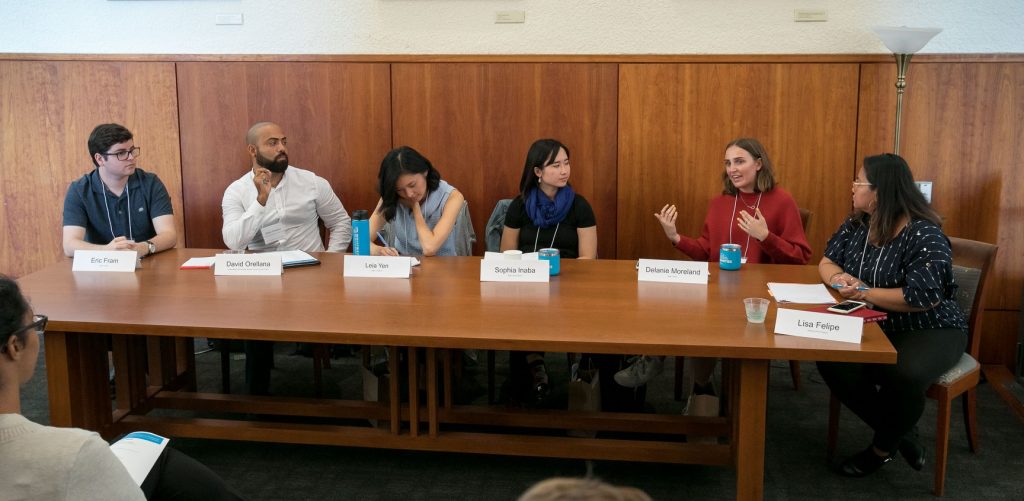
Ready, Set, Teach! began with an undergraduate forum, Undergrads on Humanities Teaching and Learning. The forum featured the following undergraduate student panelists: David Orellana; Sophia Inaba; Eric Fram; Delanie Moreland; and Leia Yen. EPIC Program Director Lisa Felipe acted as moderator. After the forum, roundtable discussions were offered on six topics: Effective Writing Assignments; Hot Moments in the Classroom; Know Your Students; Best Practices in Grading; Teaching Large Courses; and Syllabus & Course Design. Lunch was provided as attendees engaged in their choice of conversations via a rotation of small groups. The Know Your Students roundtable featured undergraduates Pallavi Adapa, Noah Hundley, and Monica Serrano. The full list of roundtable speakers and facilitators can be found here.
The participation of undergraduate students made Ready, Set, Teach! a uniquely educational experience even for the most seasoned of UCLA instructors. Today’s students come from increasingly heterogeneous backgrounds and enter UCLA with an uneven range of skills. Student preferences and expertise relative to technology, for example, may vary widely. Ready, Set, Teach! attendees demonstrated, overwhelmingly, that there is a real interest at UCLA and in the wider community in getting to know these students better.
What follows are a few highlights from the lessons learned from UCLA undergraduates at Ready, Set, Teach![1]
Undergraduates are drawn to the Humanities for its critical, introspective, and personal nature.
Sophia Inaba, a Music History major, cited a “Philosophy and Literature” GE class in which she experienced “mind-blowing moments” and would continue discussions with classmates in the sculpture garden after class.
Eric Fram, who started out as an electrical engineering major, also changed his major to English because the engineering coursework was mostly comprised of lectures and “didn’t feel personalized.” In the English Department, Eric said, “we build off each others’ ideas and I feel valued as an individual.”
One-on-one positive interactions with instructors—no matter how small or seemingly trivial—can make a world of difference in a student’s learning experience.
Many students shared a specific moment that made a deep and lasting impact on their confidence and ability to succeed in a Humanities course.
Delanie Moreland, who has experienced a lot of anxiety surrounding her classes, recalled when a professor looked at her and said “you’re gonna be ok,” and she felt a “huge weight off my shoulders.” “College is a very stressful place,” Delanie said, and UCLA students sometimes struggle with the “experience of being at a very competitive university.”
Students also appreciate when instructors make the effort to involve students in large lecture courses. “When lecture feels more like a discussion than a lecture, it is really helpful to me,” Eric said. He gave an example of an instructor pausing to learn his name after he asked a question during a large lecture.
Undergraduates are not a homogenous group, and enter the classroom with different skills and background knowledge.
Leia, a transfer student, had no exposure to research in the Humanities prior to enrolling at UCLA. For Leia, one of the most important moments in her education thus far was when a professor explained Humanities research as “entering into a conversation” or “entering a dialogue,” and developing the ability to enter into a conversation with other students. Leia explained that transfer students may need some extra attention from their instructors as they learn the ropes of their discipline. The typical transfer student, Leia explained, is “really ambitious” because they “have had to fight for their education.” One of the most difficult tasks for the transfer student is adjusting to the quarter system, and realizing that they cannot take the same workload as they did under a community college semester system.
David similarly reminded us that undocumented students are not a homogenous group, and do not all qualify for the DREAM act. They appreciate instructors that are sensitive to this fact.
Don’t assume students know the methodology of the discipline, but don’t underestimate them either.
Sophie explained that there is often a learning curve as students figure out “how this course works” but asks that instructors have faith in their students and trust that they can adapt. For first years and transfers, especially, it helps to provide detailed methodological instructions in essay prompts.
Many of the panelists expressed appreciation for instructors that invite questions and provide students with the tools for success in their class. For example, Delanie currently has an instructor that included a helpful section on the syllabus titled “How to Succeed in this Class.”
Many of the panelists also agreed that perfectionist tendencies can keep students from participating in class. In addition, Leia said that many Humanities courses involve “isms” and “ologies” that students may not have been exposed to. “We don’t know what these conversations are in the first place,” she said, “so we don’t know how to enter them.” The students believed that cultivating a culture of questions would help prevent these issues.
There was a unanimous preference for a circular seating arrangement in the classroom.
As for moving about the classroom and changing environments? Some students love it, some hate it.
Dodd 147 is Pallavi Adapa’s favorite lecture hall because of how it is configured. “I can see everyone,” she said, “and I can get a left-handed desk.”
Monica Serrano and Noah Hundley also preferred the circle configuration. Monica said that she likes to be able to “discuss face-to-face.”
Sophia Inaba said that breaks are “super helpful” in Humanities classes. “Everyone has different bodies and different needs,” she said. There should be a balance between forcing humans to sit for a long time and allowing them to stand and move, since “everyone is different biologically, and some have the ability to be still longer.”
If you missed this event, mark your calendars for the Winter Quarter Ready, Set, Teach! on Wednesday, January 23, 2019. This quarterly event features a variety of special topics on teaching and aims to build a community of engaged Humanities instructors at UCLA.
[1] Please keep in mind that this conversation, as productive as it was, represents the view of the limited number of students that volunteered for the event and who self-identified as the “speakers” in their classes.

